

Karnataka has a spectrum of topographies, cultures and food. Organised tours are often unable to provide the full range of what a region has to offer. To ensure a slower, more conscious way of tourism, Samajamukhi Prakashana, a publishing house, has come up with the novel idea of walking and witnessing the sights of Karnataka. Called ‘Nadedu Nodi Karnataka’, the tours offer an opportunity for people to experience different regions in an immersive way.
During the visit, a group speaks to residents to hear their perspectives. The visitors taste local foods, go trekking, attend cultural events and learn the history of the place.
The tour is conducted by resource people located in the area. The organisers also arrange evening programmes featuring local writers and cultural groups.
Dr Aravind Patel, a surgeon from Ballari, has been to nadiges (walks) in Sandur and B R Hills. “These tours are not just for entertainment. We have local foods, speak to villagers and organise kavigoshti (poetry readings). We hold lengthy discussions about issues in the area,” Patel says.
The 185-member team comprises people of all ages, ranging from a 10-year-old to an 86-year-old.
“Usually, tourists enjoy the beauty of temples and monuments with friends and families. Here, people from different parts of the state and various communities, irrespective of profession and age, participate in the nadige,” says Chandrakanta Vaddu, one of the organisers. Vaddu credits Indian Revenue Service officer Jayaram Raipura as one of the pioneers of this concept.
Chartered accountants, doctors, professors, IT professionals and students all participate in the nadiges.
For Savita Sonali, vice principal of an engineering college in Ballari, the tours present an opportunity to explore the taluks of her own state. “We went to the silk market in Ramanagara. In Channapatna, we saw the toy manufacturing unit. We do not get permission to see these places while visiting with family and friends,’’ Savita says.
She initially attended the tours along with her husband, and now, their sons join them in these nadiges too.
The tours are spread across three days and are organised once in two months, starting on the second Friday of the month.
The first nadige was organised four years ago in Sandur in Ballari, where the group studied mining and other industries. As many as 13 nadiges have since been held. The group has covered B R Hills, Male Mahadeshwara Hills, Banavasi, Melkote, Ramanagara, Gadag and Kolar. The next tour has been scheduled in Kundapura at the end of this month.
“When we went to Banavasi, we organised a Yakshagana programme. In Male Mahadeshwara Hills, we conducted a music programme featuring the Neelagararu community,’’ Vaddu adds.
‘Not just entertainment’
Filled with such activities, the tours can be an educational experience. In B R Hills, for instance, the nadige featured the lives of the Soligas. In Sandur, “we discussed how the region is affected by rainfall fluctuations,” Dr Patel adds. He also heard about the Lambani community and their fields of work in the areas surrounding Sandur.
The tour involves interacting with experts and resource people.
In Kolar, for example, Ramesh met a farmer who showed him how to cultivate on barren land. “He taught me how to grow plants with just gobra (manure),’’ Ramesh explains.
In the Anegundi nadige, the group saw a Bayalata performance. In Sirsi, they saw a Yakshagana performance and spoke to experts in the field.
Vidyashree Bhagavantagoudra, a journalism student from Mysuru, shares that these tours facilitate cultural and linguistic exchanges. People from different parts of Karnataka have the opportunity to converse in dialects they are not familiar with.
Speaking about the opportunities that these tours can provide, Dr Patel says, “We met writer G S Jayadev in B R Hills who is running schools to help children there.”
Those interested in photography benefit from the tours as selected pictures are printed in the magazine that the prakashana publishes.
Given its many benefits, the group hopes that the initiative will provide an avenue for collaboration with the state tourism department. “We show the places to tourists from a different angle,’’ Vaddu says.
Trekking
Trekking holds allure for many in the group. Dr Mirza Basheer, a 65-year-old veterinary doctor and award-winning writer from Tumakuru, travelled with the group to Ramanagara. “I got a rare opportunity to trek in the district despite my old age,’’ he enthuses.
The young and the old support each other, says Vidyashree.
Though the Savandurga trek was difficult, the youth helped elders in completing the trek, she adds.
Vidyashree learned about this initiative from her professor. “We also did three treks in the Ramanagara nadige and saw famous temples. I trekked in coffee estates and visited Hebbe Falls in Chikkamagaluru as well,’’ she says.
The initiative was first announced in the magazine, after which, word spread from person to person.
The community uses social media to share details about the tours. About 40 to 90 people attend each tour, and the price is fixed at Rs 4,000 per head. This covers transportation, food and accommodation for three days.